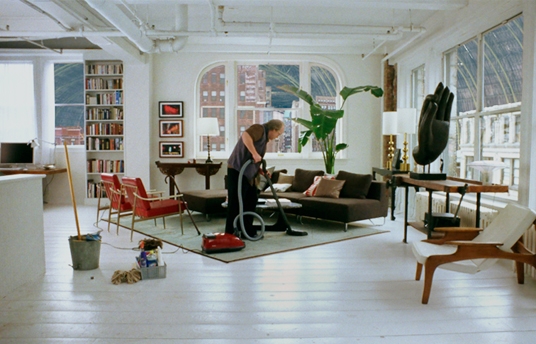DFI Film Review: Synecdoche, New York
Jan 27, 2013

By Alexander Wood
The sound of a young girl singing fills the air as the focus slowly shifts to poetry which explores death and the fall of leaves in autumn. This initial symbol of youth and decay defines the entire film and influences every waking moment of the melancholy hero and playwright, Caden Cotard (Philip Seymour Hoffman). At the beginning of the film, Caden says this is a ‘start of something awful’, and although the viewing experience is far from ‘awful’, it does challenge the viewer with a host of tragic occurrences that are weaved into multiple narratives. The narrative complexity of ‘Synecdoche, New York’, is hard to miss and the levels of storytelling are only shadowed by the surrealist elements of the film.
Everywhere you look within the film there are signposts of death from newspaper articles and cartoons to television commercials, all hinting at the inevitability of dying. Although, Caden suffers from chronic illnesses that often border on hilarious, his plight to survive is also a creative one. Without his work as a theatre director and his vision to create a play that is true, honest and worth remembering, the protagonist is but a shell of a man. The creative nature of Caden leads to his slow deterioration but also gives the character something to live for.
Despite his quest to direct his play, Caden is subject to many things beyond his control, including life in a world that is saturated with surrealist elements, which defy logic and reason. Hazel (Samantha Morton), one of the lead love interests in Caden’s life, debates purchasing a house that is in a constant state of being on fire. The scene shows a real estate agent, marketing the damaged and deteriorating property, however they make no mention of the fire raging within the walls. This is the audience’s first introduction to the surrealist elements of the film. By opening this dialogue with the surreal, the film now deviates from a given path and meanders where it decides. The death of Caden’s father is also shaped by the surreal, as he is buried in a miniature coffin having wasted away due to the extent of his tragic demise. The third surrealist element in the film motivates the plot and is seen when Caden begins reading his daughter’s diary, which starts out as a normal personal manuscript, morphing into a text that transcends time. Each time Caden turns to the diary to gain insight into his daughter’s life the book updates the narrative giving a current snapshot of her life—the journal successfully exists outside the constructs of time and reality. The diary acts as a surrealist monologue that connects the protagonist to a world that he otherwise would have never experienced.
The happiest day of Caden’s life is when he spends a night with Hazel. After finally grasping and experiencing something real—Hazel dies as a result of smoke inhalation. The burning house is the first scene that defines the surrealist elements of the film and ultimately destroys Caden’s happiness. The film captures the tragic circumstances of the lead character who claims that he ‘doesn’t feel well’ and for the remainder of the film he is in a constant state of deterioration. Experiencing everything from faucets accosting him, boils on his body, to a strange inability to produce tears, all of which become tragically funny. This constant onslaught of harmful and surreal elements ultimately influences the narrative structure of the film.
The different levels of narration within the film are one of the most unique and challenging parts of watching it. As Caden begins to create an epic play that takes over much of the film, a new level of narrative possibilities become evident to the viewer. The play begins to take on a life of its own, becoming an organism of human experience that has no boundaries. The set of his latest work is in a giant warehouse—that allows him to recreate microcosms of the real world through four different levels of narrative. One character influences the next, helping Caden’s play grow to such magnitude that it consumes him and now directs his life via an ear piece.
The narrative structure and surrealist scenes offer a challenging viewing experience, one which forces viewers to comprehend the sheer complexity of the filmmaking. Although, the film is very dense in visuals it provides a unique film watching experience that is full of death and humor.
video#1